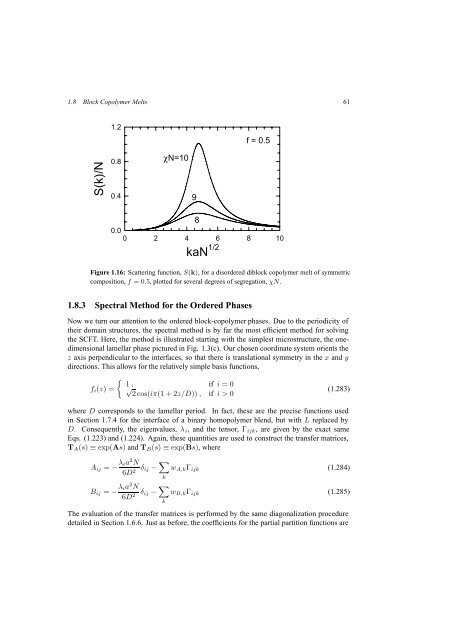Self-Consistent Field Theory and Its Applications by M. W. Matsen
Self-Consistent Field Theory and Its Applications by M. W. Matsen
Self-Consistent Field Theory and Its Applications by M. W. Matsen
You also want an ePaper? Increase the reach of your titles
YUMPU automatically turns print PDFs into web optimized ePapers that Google loves.
1.8 Block Copolymer Melts 61<br />
1.2<br />
f = 0.5<br />
S(k)/N<br />
0.8<br />
0.4<br />
χN=10<br />
9<br />
8<br />
0.0<br />
0 2 4 6 8 10<br />
kaN 1/2<br />
Figure 1.16: Scattering function, S(k), for a disordered diblock copolymer melt of symmetric<br />
composition, f =0.5, plotted for several degrees of segregation, χN.<br />
1.8.3 Spectral Method for the Ordered Phases<br />
Now we turn our attention to the ordered block-copolymer phases. Due to the periodicity of<br />
their domain structures, the spectral method is <strong>by</strong> far the most efficient method for solving<br />
the SCFT. Here, the method is illustrated starting with the simplest microstructure, the onedimensional<br />
lamellar phase pictured in Fig. 1.3(c). Our chosen coordinate system orients the<br />
z axis perpendicular to the interfaces, so that there is translational symmetry in the x <strong>and</strong> y<br />
directions. This allows for the relatively simple basis functions,<br />
f i (z) =<br />
{ 1 , if i =0<br />
√<br />
2cos(iπ(1 + 2z/D)) , if i>0<br />
(1.283)<br />
where D corresponds to the lamellar period. In fact, these are the precise functions used<br />
in Section 1.7.4 for the interface of a binary homopolymer blend, but with L replaced <strong>by</strong><br />
D. Consequently, the eigenvalues, λ i , <strong>and</strong> the tensor, Γ ijk , are given <strong>by</strong> the exact same<br />
Eqs. (1.223) <strong>and</strong> (1.224). Again, these quantities are used to construct the transfer matrices,<br />
T A (s) ≡ exp(As) <strong>and</strong> T B (s) ≡ exp(Bs), where<br />
A ij = − λ ia 2 N<br />
6D 2 δ ij − ∑ k<br />
B ij = − λ ia 2 N<br />
6D 2 δ ij − ∑ k<br />
w A,k Γ ijk (1.284)<br />
w B,k Γ ijk (1.285)<br />
The evaluation of the transfer matrices is performed <strong>by</strong> the same diagonalization procedure<br />
detailed in Section 1.6.6. Just as before, the coefficients for the partial partition functions are
















